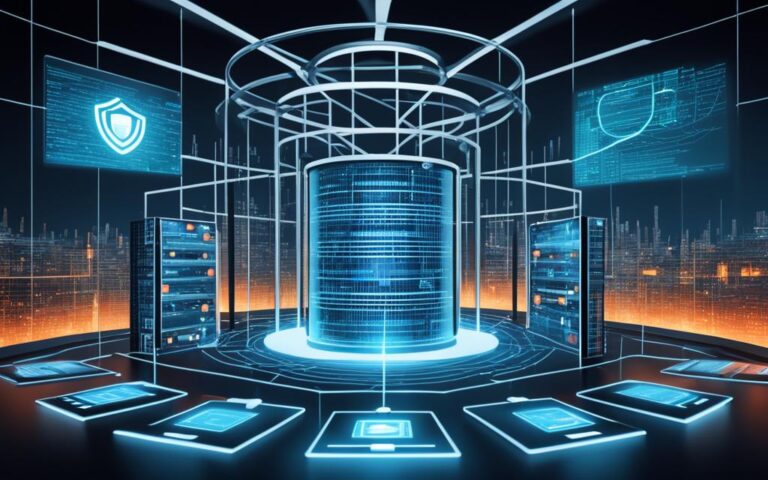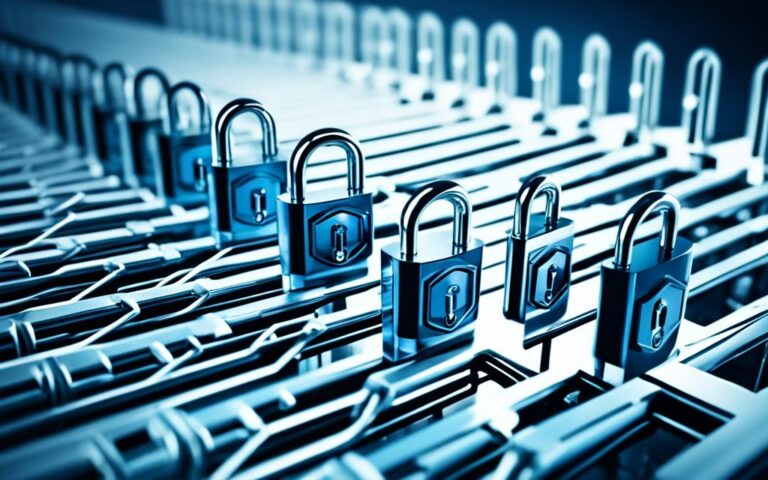The Intersection of Data Destruction and Cybersecurity Measures
Cybersecurity measures and data destruction play vital roles in safeguarding business and personal data from cyber threats. As technology continues to advance, the risk of data breaches and unauthorized access becomes increasingly prevalent. To protect the integrity of data and mitigate potential cyber threats, organizations must adopt effective cybersecurity measures and implement robust data destruction practices.
Cybersecurity measures encompass a range of strategies and technologies aimed at identifying, preventing, and responding to cyber threats. These measures include network security systems, firewalls, encryption, and intrusion detection systems. By implementing these measures, organizations can establish strong barriers against cyberattacks and unauthorized access.
Data destruction, on the other hand, ensures that sensitive information is permanently removed from storage media, such as hard drives, to prevent any potential data breaches. This process involves securely erasing or physically destroying data to make it unrecoverable. Proper data destruction is essential when disposing of old or damaged hardware, as it eliminates the risk of data being accessed or retrieved.
By combining cybersecurity measures with effective data destruction practices, organizations can protect the integrity and confidentiality of their data. This comprehensive approach minimizes the risk of data breaches and reinforces data privacy.
The Importance of Cybersecurity and Privacy
Cybersecurity and privacy play a crucial role in safeguarding the confidentiality, integrity, and availability of data. These two aspects work hand in hand to prevent unauthorized access, modification, or destruction of valuable information. Additionally, they provide protection for personal information, ensuring that it remains secure and inaccessible to unauthorized individuals.
In today’s digital landscape, where organizations heavily rely on technology for data storage and management, cybersecurity and privacy have become even more essential. As cyber threats continue to evolve, it is paramount for businesses to prioritize the implementation of robust cybersecurity measures and privacy practices.
“Cybersecurity and privacy are essential for protecting sensitive data and maintaining customer trust in an increasingly interconnected world.”
Cybersecurity measures, such as firewalls, encryption, and intrusion detection systems, form a defense against unauthorized access and cyber attacks. These measures ensure that data remains protected and out of the hands of malicious actors.
Privacy, on the other hand, focuses on the collection, storage, and use of personal information. By enforcing privacy policies and implementing privacy-enhancing technologies, organizations can assure individuals that their personal data will not be misused or disclosed without their consent.
The need for cybersecurity and privacy extends to both individuals and businesses. For individuals, it involves protecting personal information, such as credit card details, social security numbers, and medical records, from falling into the wrong hands. On a larger scale, organizations must protect sensitive data, trade secrets, and customer information from unauthorized access and illegal breaches.
The Consequences of Inadequate Cybersecurity and Privacy
The repercussions of inadequate cybersecurity and privacy measures can be severe. Unauthorized access to personal information can result in identity theft, fraud, and financial loss for individuals. For organizations, data breaches can lead to reputational damage, legal consequences, and significant financial implications.
Moreover, as technology continues to advance, the threat landscape expands. Emerging technologies such as artificial intelligence, internet of things (IoT), and cloud computing bring about new challenges in maintaining cybersecurity and privacy. Organizations must stay vigilant and adapt their security measures to protect against evolving threats.
“In today’s interconnected world, cybersecurity and privacy are no longer optional; they are imperative.”
By prioritizing cybersecurity and privacy, organizations can build trust with their customers, maintain compliance with data protection regulations, and ensure the integrity of their data. It is crucial to implement comprehensive security measures and privacy practices to mitigate the risks associated with unauthorized access and protect valuable personal information.
Balancing Cybersecurity and Privacy
When it comes to protecting sensitive data, finding the right balance between cybersecurity and privacy is crucial. This requires a multi-faceted approach that incorporates various measures to safeguard information and mitigate risks.
One of the key steps in achieving this balance is conducting risk assessments to identify potential threats and vulnerabilities. By assessing the security landscape, organizations can prioritize their efforts and allocate resources effectively.
Another essential aspect is implementing encryption to protect sensitive data from unauthorized access. Encryption transforms data into an unreadable format, making it difficult for cybercriminals to decipher. This ensures that even if the data is intercepted, it remains secure and protected.
Access control plays a vital role in maintaining cybersecurity and privacy. By implementing strong access control measures, such as authentication and password policies, organizations can restrict unauthorized individuals from gaining access to sensitive information.
Incorporating privacy by design principles into the development process is another important consideration. This means incorporating privacy measures from the outset, rather than as an afterthought, ensuring that privacy is integrated into every aspect of the system.
Establishing data retention policies is essential for balancing cybersecurity and privacy. Organizations need to define how long data should be retained and develop procedures for securely disposing of data that is no longer needed. Clear data retention policies help prevent data from being stored longer than necessary, minimizing the risk of unauthorized access.
Transparency is key to maintain trust with users and customers. Adopting transparent data practices allows individuals to have visibility into how their data is being handled, ensuring that organizations are accountable for their data privacy commitments.
Benefits of Balancing Cybersecurity and Privacy
By effectively balancing cybersecurity and privacy, organizations can enjoy several benefits:
- Enhanced data protection: Implementing a comprehensive approach to security and privacy ensures the confidentiality, integrity, and availability of data.
- Compliance with regulations: Organizations can ensure compliance with data protection regulations and avoid legal consequences.
- Customer trust: Demonstrating a commitment to privacy and data security builds trust with customers, enhancing the organization’s reputation.
- Reduced risks: Balancing cybersecurity and privacy reduces the risks of data breaches, unauthorized access, and potential reputational damage.
By adopting a proactive approach to cybersecurity and privacy, organizations can successfully navigate the digital landscape while protecting sensitive information.
| Cybersecurity Measures | Data Privacy |
|---|---|
| Risk assessments | Privacy by design |
| Encryption | Data retention policies |
| Access control | Transparent data practices |
Implementing these measures in harmony ensures not only robust cybersecurity protocols but also respects individuals’ privacy rights. Organizations that prioritize both cybersecurity and privacy gain a competitive edge by safeguarding sensitive data and fostering trust with their stakeholders.
Challenges to Balancing Cybersecurity and Privacy
The seamless integration of cybersecurity measures and data privacy poses numerous challenges for organizations. The delicate balance between security and user experience, compliance with regulations, the complexity of systems, insider threats, and emerging technologies demands careful consideration and proactive strategies.
Security vs User Experience
One major challenge is finding the right balance between security measures and providing a user-friendly experience. Stringent security protocols such as complex password requirements and multi-factor authentication can enhance protection but may also hinder usability and frustrate users.
Compliance with Regulations
Complying with ever-evolving regulations presents another hurdle in ensuring robust cybersecurity and privacy practices. Organizations need to stay up-to-date with changing laws, navigate the complexities of data protection regulations, and implement appropriate measures to remain in compliance.
Complexity of Systems
The increasing complexity of systems and technologies makes it difficult to maintain comprehensive cybersecurity measures. With interconnected networks, cloud services, and a wide range of devices and applications, organizations must navigate intricate landscapes to address vulnerabilities effectively.
Addressing Insider Threats
Insider threats, whether intentional or accidental, can compromise cybersecurity and privacy. Organizations need to implement stringent user access controls, employee training programs, and monitoring systems to mitigate internal risks and protect sensitive data.
Staying Ahead of Emerging Technologies
The rapid pace of technological advancements introduces new challenges for cybersecurity and privacy. Organizations must continuously adapt their strategies to address emerging threats posed by innovations such as artificial intelligence, Internet of Things (IoT), and cloud computing.
Aligning cybersecurity and privacy while tackling these challenges requires comprehensive strategies, proactive measures, and ongoing vigilance. Organizations must prioritize both areas to safeguard sensitive information, maintain trust, and mitigate the evolving threat landscape.
Conclusion
The seamless integration of cybersecurity measures and data privacy is imperative for organizations to protect sensitive information. In today’s digital landscape, where cyber threats are ever-evolving, organizations need to take proactive steps to safeguard their data. By implementing robust cybersecurity measures, such as conducting regular risk assessments, encrypting sensitive data, and establishing access control protocols, organizations can mitigate the risk of unauthorized access and data breaches.
Adhering to compliance requirements is also crucial in protecting data privacy. By staying up to date with industry regulations and privacy laws, organizations can ensure that they are meeting the necessary standards and protecting the privacy rights of individuals. This includes incorporating privacy by design principles into the development of systems and adopting transparent data practices to enhance accountability.
Organizations must adopt a proactive approach to information security, constantly monitoring and adapting to emerging threats. By investing in employee training and awareness programs, organizations can address the insider threat, where unintentional or malicious actions by employees can compromise sensitive data. Staying ahead of emerging technologies, such as artificial intelligence and the Internet of Things, is also essential in maintaining effective cybersecurity measures.
In conclusion, protecting sensitive information requires a comprehensive approach that encompasses both cybersecurity measures and data privacy. By implementing robust security protocols, adhering to compliance requirements, and adopting proactive information security processes, organizations can navigate the digital landscape with confidence, safeguarding the integrity, confidentiality, and availability of critical data.
FAQ
What are the key factors to consider for data protection?
Balancing cybersecurity and privacy involves conducting risk assessments, implementing encryption, access control, privacy by design, establishing data retention policies, and transparent data practices.
Why are cybersecurity and privacy important?
Cybersecurity and privacy are essential for protecting the confidentiality, integrity, and availability of data. They help prevent unauthorized access, modification, or destruction of data and protect personal information.
How can cybersecurity and privacy be balanced?
Balancing cybersecurity and privacy requires a multi-faceted approach. This includes conducting risk assessments, implementing encryption, ensuring access control, incorporating privacy considerations, establishing data retention policies, and adopting transparent data practices.
What are the challenges in balancing cybersecurity and privacy?
The challenges include balancing security with user experience, compliance with regulations, managing system complexity, addressing insider threats, and keeping up with emerging technologies.
How can organizations protect sensitive information?
Organizations can protect sensitive information by implementing robust cybersecurity measures, adhering to compliance requirements, and adopting proactive information security processes.













